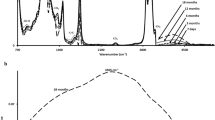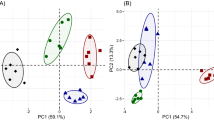Abstract
The phenolic compound concentration of olives and olive oil is typically quantified using HPLC; however, this process is expensive and time consuming. The purpose of this work was to evaluate the potential of Fourier transform infrared (FTIR) spectroscopy combined with chemometrics, as a rapid tool for the quantitative prediction of phenol content and antioxidant activity in olive fruits and oils from “Cobrançosa” cultivar. Normalized spectral data using standard normal variate (SNV) and first and second Savitzky–Golay derivatives were used to build calibration models based on principal component regression (PCR) and on partial least squares regression (PLS-R), the performance of both models have been also compared. It was shown the possibility of establishing optimized regression models using the combined frequency regions of 3050–2750 and 1800–790 cm−1 instead of the full mid-infrared spectrum was shown. It was concluded that, in general, the first derivative of data and PLS-R models offered enhanced results. Low root-mean-square error (RMSE) and high correlation coefficients (R 2) for the calibration and for the validation sets were obtained.



Similar content being viewed by others
References
Amaral SJ, Mafra I, Oliveira MBP (2010) In: Olives and olive oil in health and disease prevention. Victor R. Preedy and Ronald Ross Watson (eds). Academic Press, Oxford
Baccouri O, Guerfel M, Baccouri B, Cerratani L, Bendini A, Lercker G, Zarrouck M, Miled DDB (2008) Chemical composition and oxidative stability of Tunisian monovarietal virgin olive oils with regard to fruit ripening. Food Chem 109:743–754
Barros A I, Freire I, Gonçalves B, Bacelar E, Gomes S, Lopes J, Guedes-Pinto H, Martins-Lopes P (2013) Evaluation of chemical and phenotipic changes in Blanqueta, Cobrançosa and Galega during olive fruits ripening. Cyta 11:136–141
Bendini A, Cerretani L, Di Virgilio F, Belloni P, Bonoli-Carbognin M, Lercker G (2007) Preliminary evaluation of the application of the FTIR spectroscopy to control the geographic origin and quality of virgin olive oil. J Food Quality 30(4):424–437. doi:10.1111/j.1745-4557.2007.00132.x
Bendini A, Cerretani L, Virgilio F, Belloni P, Lercker G, Toschi TG (2007b) In-process monitoring in industrial olive mil by means of FT-NIR. Eur J Lipid Sci Technol 109:498–504
Bosque-Sendra JM, Cuadros-Rodriguez L, Chiavaro E, Kaufman T, Bendini A (2010) Combining chromatography and chemometrics for the characterization and authentication of fats and oils from triacylglycerol compositional data—a review. Anal Chim Acta 724:1–11
Che Man YB, Syahariza ZA, Mirghani MES, Jinap S, Bakar J (2005) Analysis of potential lard adulteration in chocolate and chocolate products using Fourier transform infrared spectroscopy. Food Chem 90:815–819
Duarte I, Barros A, Delgadillo I, Almeida C, Gil A (2002) Application of FTIR spectroscopy for the quantification of sugars in mango juice as a function of ripening. J Agr Food Chem 50:3104–3111
Dupuy N, Galtier O, Ollivier D, Vanloot P, Artaud J (2010) Comparison between NIR, MIR, concatenated NIR and MIR analysis and hierarchical PLS model. Application to virgin olive oil analysis. Anal Chim Acta 666:23–31
Jorgensen K, Segtnan V, Thyholt K, Naes T (2004) A comparison of methods for analysing regression models with both spectral and designed variables. J. Chemometrics 18:451–461
Kalua CM, Allen MS, Bedgood DR, Bishop AG, Prenzler PD (2005) Discrimination of olive oils and fruit into cultivars and maturity stages based on phenolic and volatile compounds. J Agr Food Chem 53:8054–8062
Karoui R, Downey G, Blecker C (2010) Mid-infrared spectroscopy couple with chemometrics: a tool for the analysis of intact food systems and exploration of their molecular structure-quality relationships. A Review Chemical Rev 110:6144–6168
Kuligwski J, Quintás G, Garrigues S, Guardia M (2010) Direct determination of polymerized triglycerides in deep frying olive oil by attenuated total reflectance-Fourier transform infrared spectroscopy using partial least squares regression. Anal Bioanal Chem 397:861–869
Lachenmeir D (2007) Rapid quality control of spirit drinks and beer using multivariate data analysis of Fourier transform infrared spectra. Food Chem 101:825–832
Lerma-Garcia M, Ramis-Ramos G, Herrero-Martinez JM, Simó-Alfonso EF (2010) Authentication of extra virgin olive oils by Fourier-transform infrared spectroscopy. Food Chem 118:78–83
Lukic M, Lukic I, Krapac M, Sladanja B, Plilizot V (2013) Sterols and triterpenic diols in olive oil as indicators of variety and degree of ripening. Food Chem 136:251–258
Machado M, Felizardo C, Fernandes-Silva AA, Nunes FM, Barros A (2013) Polyphenolic compounds, antioxidant activity and L-phenylalanine ammonia-lyase activity during ripening of olive cv. “Cobrançosa” under different irrigation regimes. Food Res Int 51:412–421
Maggio RM, Cerretani L, Chiavaro E, Kaufman TS, Bendini A (2010) A novel chemometric strategy for the estimation of extra virgin olive oil adulteration with edible oils. Food Control 21:890–895
Maggio RM, Kaufman T, Del Carlo M, Cerretani L, Bendini A, Cichelli A, Compagnone D (2009) Monitoring of fatty acid composition in virgin olive oil by Fourier transformed infrared spectroscopy couple with partial least squares. Food Chem 114:1549–1554
Martins-Lopes P, Gomes S, Lima-Brito J, Lopes J, Guedes-Pinto H (2009) Assessment of clonal genetic variability in Olea europaea L. ‘Cobrançosa’ by molecular markers. Sci Hortic 123:82–89
Matos LC, Cunha SC, Amaral JS, Pereira JA, Andrade PB, Seabra RM, Oliveira BPP (2007) Chemometric characterization of three varietal olive oils (cvs Cobrançosa, Madural and Verdeal Transmontana), extracted from olives with different maturation indices. Food Chem 102:406–414
Miller JN, Miller JC (2005) In: Statistics and Chemometrics for Analytical Chemisitry 5th Edition; Pearson Education Limited, Edinburgh Gate, Harlow, UK
Morelló JR, Romero MP, Ramo T, Motilva MJ (2005) Evaluation of L-phenylalanine ammonia-lyase activity and phenolic profile in olive drupe (Olea europaea L.) from fruit setting period to harvesting time. Plant Sci 168:65–72
Nunes A, Martins J, Barros AS, Galvis-Sánchez AC, Delgadillo I (2009) Estimation of olive oil acidity using FT-IR and partial least squares regression. Sens Instrum Food Qual 3:187–191
Rohman A, Che Man YB (2010) Fourier transform infrared (FTIR) spectroscopy for analysis of extra virgin olive oil adulterated with palm oil. Food Res Int 43:886–892
Rohman A, Che Man YB (2012) The chemometrics approach applied to FTIR spectral data for the analysis of rice bran oil in extra virgin olive oil. Chemometr Intell Labo 110:129–134
Romera-Fernández M, Berruera LA, Garmón-Lobato S, Gallo B, Vicente F, Moreda JM (2012) Feasibility study of FT-MIR spectroscopy and PLS-R for the fast determination of anthocyanins in wine. Talanta 88:303–310
Ruth SM, Villegas B, Akkermans W, Rozign M, Kamp H, Koot A (2010) Prediction of the identity of fats and oils by their fatty acid, triacylglycerol and volatile compositions using PLS-DA. Food Chem 118:48–955
Safar M, Bertrand D, Rober P, Devaux MF, Genot C (1994) Characterization of edible oils, butter and margarines by Fourier transform infrared spectroscopy with attenuated total reflectance. J Am Oil Chem Soc 71:371–377
Salvador MD, Aranda F, Fregapane G (2001) Influence of fruit ripening on “Cornicabra” virgin olive oil quality: a study of four successive crop seasons. Food Chem 73:45–53
Sinelli N, Cerretani L, Di Egidio V, Bendini A, Casiraghi E (2010) Application of near (NIR) infrared and mid (MIR) infrared spectroscopy as a rapid tool to classify extra virgin olive oil on basis of fruit attribute intensity. Food Res Int 43:369–367
Sinelli N, Cosio MS, Gigliotti C, Casiraghi E (2007) Preliminary study on application of mid infrared spectroscopy of the evaluation of the virgin olive oil “freshness”. Anal Chim Acta 598:128–134
Smith BC (2002) Quantitative spectroscopy: theory and practice. Academic, Amsterdam, pp 125–179
Sousa C, Gouvinhas I, Barreira D, Carvalho MI, Vilela A, Lopes J, Martins-Lopes M, Barros AI (2014) ‘Cobrançosa’ olive oil and drupe: chemical composition in two ripening stages. J Am Oil Chem Soc 91(4): 599–611. doi: 10.1007/s11746-013-2406-x
Tapp HS, Defernez M, Kemsley K (2003) FTIR spectroscopy and multivariate analysis can distinguish the geographic origin of extra virgin olive oils. J Agr Food Chem 51:6110–6115
Tovar MJ, Romero MP, Girona J, Motilva MJ (2002) L-Phenylalanine ammonia-lyase activity and concentration of phenolics in developing olive (Olea europaea L. cv Arbequina) fruit grown under different irrigation regimes. J Sci Food Agr 82:892–898
Uceda M, Hermoso M (1998) La calidad del aceite de olive. In D. Barranco, R., Fernandez Escobar, L. Rallo (eds), El cultivo del olivo, Madrid, Spain: Junta de Andalucia Ediciones Mundi-Prensa, pp. 547–572
Wentzell PD, Montoto LV (2003) Comparison of principal components regression and partial least squares regression through generic simulations of complex mixtures. Chemometr. Intell. Lab. Systems 65:257–279
Wold S, Sjostrom M, Erikson L (2001) PLS-regression: a basic toll of chemometrics. Chemometr Intel Lab 58:109–130
Xie Y-L, Kalivas JH (1997) Local prediction models by principal components regression. Anal Chim Acta 348:29–38. doi: 10.1016/S0003-2670(97)00036-6
Acknowledgments
This work was supported by the Project PhD grant SFRH/BD/78013/2011 to IG from the Fundação para a Ciência e a Tecnologia.
This work is financed by the European Regional Development Fund (ERDF) through the COMPETE Programme (Operational Programme for Competitiveness) and by National Funds through the Fundação para a Ciência e a Tecnologia (FCT) (Portuguese Foundation for Science and Technology) within project FCOMP-01-0124-FEDER-037281.
This work is supported by national funds by FCT—Portuguese Foundation for Science and Technology, under the project PEst-OE/AGR/UI4033/2014 and Project INNovation in the FOOD (INNOFOOD) sector through the valorization of food and agro-food by-products (NORTE-07-0124-FEDER-0000029), financed by the North Portugal Regional Operational Programme (ON.2 – O Novo Norte) under the National Strategic Reference Framework (QREN), through FEDER, as well as by PIDDAC through FCT/MEC.
Compliance with Ethics Requirements
Manuela Machado has no conflict of interest. Nelson Machado has no conflict of interest. Irene Gouvinhas has no conflict of interest. Maria Cunha has no conflict of interest. José Almeida has no conflict of interest. Ana Barros has no conflict of interest. This article does not contain any studies with human or animal subjects.
Author information
Authors and Affiliations
Corresponding author
Rights and permissions
About this article
Cite this article
Machado, M., Machado, N., Gouvinhas, I. et al. Quantification of Chemical Characteristics of Olive Fruit and Oil of cv Cobrançosa in Two Ripening Stages Using MIR Spectroscopy and Chemometrics. Food Anal. Methods 8, 1490–1498 (2015). https://doi.org/10.1007/s12161-014-0017-2
Received:
Accepted:
Published:
Issue Date:
DOI: https://doi.org/10.1007/s12161-014-0017-2




